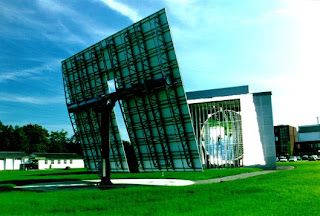Solar power in India

With about 300 clear, sunny days in a year, India's theoretical solar power reception, on only its land area, is about 5000 Petawatt-hours per year (PWh/yr) (i.e. 5000 trillion kWh/yr or about 600 TW).[5][6] The daily average solar energy incident over India varies from 4 to 7 kWh/m2 with about 1500–2000 sunshine hours per year (depending upon location), which is far more than current total energy consumption. For example, assuming the efficiency of PV modules were as low as 10%, this would still be a thousand times greater than the domestic electricity demand projected for 2015.[5][7][edit]Installed capacity The amount of solar energy produced in India in 2007 was less than 1% of the total energy demand.[8] The grid-interactive solar power as of December 2010 was merely 10 MW.[9] Government-funded solar energy in India only accounted for approximately 6.4 MW-yr of power as of 2005.[8]
 However, India is ranked number one in terms of solar energy production per watt installed, with an insolation of 1,700 to 1,900 kilowatt hours per kilowatt peak (kWh/KWp).[10] 25.1 MW was added in 2010 and 468.3 MW in 2011.[11] By July 2012 the installed grid connected photovoltaics had increased to 1040.67 MW,[12] and India expects to install an additional 10,000 MW by 2017, and a total of 20,000 MW by 2022.[13] Solar power in Gujarat Main article: Gujarat Solar Park Gujarat has been a leader in solar power generation and contributes 2/3rd of the 900 MW of photovoltaics in the country. The State has commissioned Asia’s biggest solar park at Charanka village. The park is already generating 214 MW solar power out of its total planned capacity of 500 MW. The park has been functioning on a multi-developers and multi-beneficiaries paradigm and has been awarded for being the most innovative and environment-friendly project by the CII. With a view to make Gandhinagar a solar city, the State government has launched a roof-top solar power generation scheme. Under this scheme, the State plans to generate five megawatt of solar power by putting solar panels on about 50 state government buildings and on 500 private buildings. The State has also a plan to emulate this project in Rajkot, Surat, Bhavnagar and Vadodara in 2012-13. The State plans to generate solar power by putting solar panels on the Narmada canal branches. As a part of this scheme, the State has already commissioned a one megawatt solar plant on a branch of the Narmada Canal near Chandrasan area of Anand taluka. This also helps by stopping 90,000 liter water/year of the Narmada river from evaporating. [edit]Solar power in Rajasthan Next to Gujarat, Rajasthan is India's sunniest state, and many solar projects have been proposed. The 40 MW photovoltaic Dhirubhai Ambani Solar Park was completed in April 2012.[18] A 250 MW compact linear fresnel reflector (CLFR) plant is under construction, consisting of two 125 MW sections.[47] [edit]Solar power in Maharastra The Shri Sai Baba Sansthan Trust has world's largest solar steam system. It was constructed at the Shirdi shrine at an estimated cost of Rs.1.33 crore, Rs.58.4 lakh of which was paid as a subsidy by the renewable energy ministry. The system is used to cook 50,000 meals per day for pilgrims visiting the shrine, resulting in annual savings of 100,000 kg of cooking gas and has been designed to generate steam for cooking even in the absence of electricity to run the feed water pump for circulating water in the system. The project to install and commission the system was completed in seven months and the system has a design life of 25 years
However, India is ranked number one in terms of solar energy production per watt installed, with an insolation of 1,700 to 1,900 kilowatt hours per kilowatt peak (kWh/KWp).[10] 25.1 MW was added in 2010 and 468.3 MW in 2011.[11] By July 2012 the installed grid connected photovoltaics had increased to 1040.67 MW,[12] and India expects to install an additional 10,000 MW by 2017, and a total of 20,000 MW by 2022.[13] Solar power in Gujarat Main article: Gujarat Solar Park Gujarat has been a leader in solar power generation and contributes 2/3rd of the 900 MW of photovoltaics in the country. The State has commissioned Asia’s biggest solar park at Charanka village. The park is already generating 214 MW solar power out of its total planned capacity of 500 MW. The park has been functioning on a multi-developers and multi-beneficiaries paradigm and has been awarded for being the most innovative and environment-friendly project by the CII. With a view to make Gandhinagar a solar city, the State government has launched a roof-top solar power generation scheme. Under this scheme, the State plans to generate five megawatt of solar power by putting solar panels on about 50 state government buildings and on 500 private buildings. The State has also a plan to emulate this project in Rajkot, Surat, Bhavnagar and Vadodara in 2012-13. The State plans to generate solar power by putting solar panels on the Narmada canal branches. As a part of this scheme, the State has already commissioned a one megawatt solar plant on a branch of the Narmada Canal near Chandrasan area of Anand taluka. This also helps by stopping 90,000 liter water/year of the Narmada river from evaporating. [edit]Solar power in Rajasthan Next to Gujarat, Rajasthan is India's sunniest state, and many solar projects have been proposed. The 40 MW photovoltaic Dhirubhai Ambani Solar Park was completed in April 2012.[18] A 250 MW compact linear fresnel reflector (CLFR) plant is under construction, consisting of two 125 MW sections.[47] [edit]Solar power in Maharastra The Shri Sai Baba Sansthan Trust has world's largest solar steam system. It was constructed at the Shirdi shrine at an estimated cost of Rs.1.33 crore, Rs.58.4 lakh of which was paid as a subsidy by the renewable energy ministry. The system is used to cook 50,000 meals per day for pilgrims visiting the shrine, resulting in annual savings of 100,000 kg of cooking gas and has been designed to generate steam for cooking even in the absence of electricity to run the feed water pump for circulating water in the system. The project to install and commission the system was completed in seven months and the system has a design life of 25 years












No comments:
Post a Comment